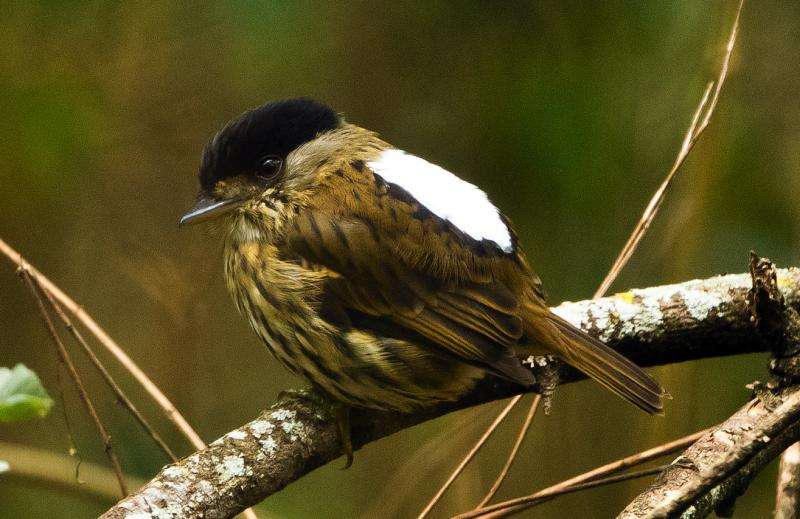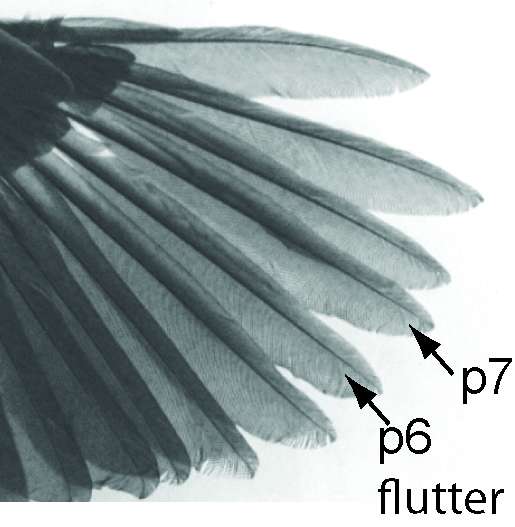Researchers document how broadbills make loud wing song

Broadbills - birds found in some parts of Africa - produce a startlingly loud sound that they make with their wings to mark off territory. Males fly abruptly in a tight circle, landing where they began, and produce a klaxon-like sound - brreeeeet! - that they could also be using to attract females. Researchers have hypothesized that it is the outermost wing feathers that make the sound, but no studies have been conducted to verify this hypothesis.
A team of researchers led by a biologist at the University of California, Riverside has now conducted a study that shows that it is not the outermost wing feathers but the ones just inside of these feathers that make the klaxon-like sound.
"We got high-speed videos of these birds in Uganda to see how they flap their wings," said Christopher J. Clark, an assistant professor of biology who led the study. "We then tested the feathers in a wind tunnel to reproduce the sound. We found that it is not the outermost three wing feathers that flutter, but two feathers just inside of these outermost ones."
Study results appear in the March 30 issue of the Journal of Experimental Biology.
When a person walks down a hallway, his/her footsteps make a sound that could be used to communicate a message, such as who the person is. One possibility, according to Clark, is that when birds, like broadbills, are engaged in their behavioral displays, they make sounds with their feathers that eventually get coopted into a communication signal.

"What's interesting is that broadbills are only distantly related to other birds, like hummingbirds, that use their feathers to make sounds," Clark said. "In the case of broadbills, this is an independent evolution of making sounds with feathers. The wing song appears to have functionally replaced vocal song."
Broadbills are poorly studied largely because they are found only in remote areas in Africa. To capture footage of the birds, Clark and his team flew to Uganda, where, escorted by an armed park guard, they had to drive over bumpy dirt roads for several hours to get to remote regions near the country's border with the Democratic Republic of Congo - an area visited by very few people.
"We had to load high-speed cameras with heavy battery belts and haul them out into the jungle," Clark said. "Such cameras also need a lot of light to work. Broadbills, however, live in the dark understory of jungles in Africa - which posed yet another challenge."
In most species of birds that use their feathers to make sounds, the feathers are distinctly modified. But the high-speed videos Clark and his team took in Uganda showed that the sound-producing feathers in broadbills are not modified.
"These feathers, named P6 and P7, are not narrow, twisted or stiffened in any way," Clark said. "Indeed, there is nothing remarkable about their shape and nothing about them betrays their role. The broadbill is using its wings as an instrument, yet when we look at the wing feathers, there is no obvious modification to the feathers to make them into a musical instrument."
The male broadbill is a brown bird, about five inches tall, and weighs about 30 grams. When it does its display, a white patch on its rump becomes visible. It usually initiates this display by jumping and rotating 180 degree in yaw. The klaxon-like sound that males make lasts about a second and can travel more than 100 meters in the jungle. The synchronized high-speed video and sound recordings of displays in the field that Clark and his colleagues took showed that the P6 and P7 feathers, the primary sound-producing feathers, flutter a thousand times per second to make the sound. The sound pulses are produced during the downstroke. Feathers P5 and P8 may be involved in sound production; P9 and P10 are not.
Birds have evolved to make sounds with their wings or tails at least 69 times across the entire bird clade, Clark explained.
"This is certain to be an underestimate," he said. "This is because many sounds are poorly described. Also, it is hard to tell if a sound being produced is for communication or just an incidental byproduct of flight. We know that all birds make sounds when they fly. In some cases, the sound is distinctive. For example, ducks make a whistling sound when they fly. It is not easy to tell, however, if this is communication by them or just a byproduct of them flapping their wings."
Clark collected field data for the study when he was a postdoc at Yale University. He was joined in the study by Alexander N. G. Kirschel and Louis Hadjioannou at the University of Cyprus; and Richard P. Prum at Yale University, Conn.
All four researchers traveled to Uganda in 2011 to get the initial high speed videos and sound recordings. At Yale, Clark did experiments with broadbill feathers in a wind tunnel and collected the data. He joined UC Riverside in 2013.
"This work helps us understand biodiversity," he said. "Animals live their lives in many extraordinary ways. This work uncovers yet another pocket of diversity."
More information: Clark, C. J., Kirschel, A. N. G., Hadjioannou, L. and Prum, R. O. (2016). Smithornis broadbills produce loud wing song by aeroelastic flutter of medial primary wing feathers. J. Exp. Biol. 219, DOI: 10.1242/jeb.131664
Journal information: Journal of Experimental Biology
Provided by University of California - Riverside


















